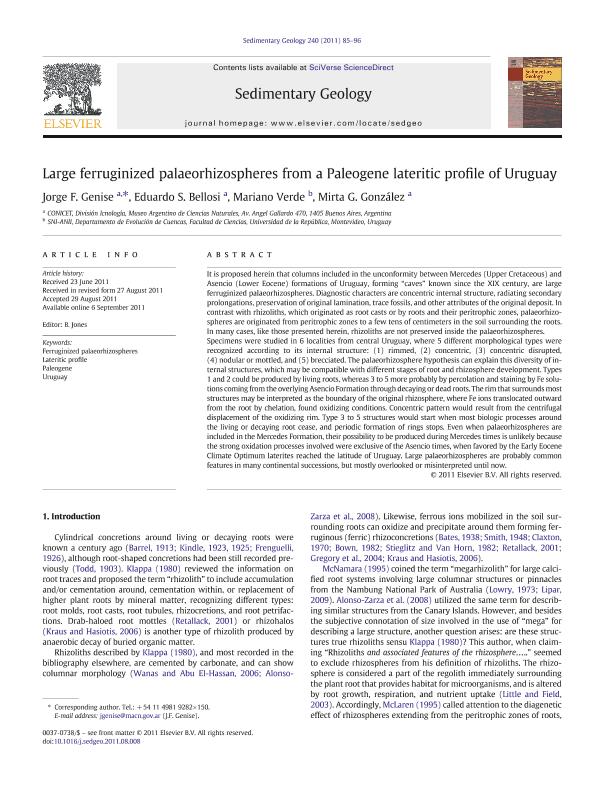Mostrar el registro sencillo del ítem
dc.contributor.author
Genise, Jorge Fernando

dc.contributor.author
Bellosi, Eduardo Sergio

dc.contributor.author
Verde, Mariano

dc.contributor.author
Gonzalez, Mirta Gladys

dc.date.available
2019-01-29T20:42:58Z
dc.date.issued
2011-10
dc.identifier.citation
Genise, Jorge Fernando; Bellosi, Eduardo Sergio; Verde, Mariano; Gonzalez, Mirta Gladys; Large ferruginized palaeorhizospheres from a Paleogene lateritic profile of Uruguay; Elsevier Science; Sedimentary Geology; 240; 3-4; 10-2011; 85-96
dc.identifier.issn
0037-0738
dc.identifier.uri
http://hdl.handle.net/11336/68930
dc.description.abstract
It is proposed herein that columns included in the unconformity between Mercedes (Upper Cretaceous) and Asencio (Lower Eocene) formations of Uruguay, forming "caves" known since the XIX century, are large ferruginized palaeorhizospheres. Diagnostic characters are concentric internal structure, radiating secondary prolongations, preservation of original lamination, trace fossils, and other attributes of the original deposit. In contrast with rhizoliths, which originated as root casts or by roots and their peritrophic zones, palaeorhizospheres are originated from peritrophic zones to a few tens of centimeters in the soil surrounding the roots. In many cases, like those presented herein, rhizoliths are not preserved inside the palaeorhizospheres.Specimens were studied in 6 localities from central Uruguay, where 5 different morphological types were recognized according to its internal structure: (1) rimmed, (2) concentric, (3) concentric disrupted, (4) nodular or mottled, and (5) brecciated. The palaeorhizosphere hypothesis can explain this diversity of internal structures, which may be compatible with different stages of root and rhizosphere development. Types 1 and 2 could be produced by living roots, whereas 3 to 5 more probably by percolation and staining by Fe solutions coming from the overlying Asencio Formation through decaying or dead roots. The rim that surrounds most structures may be interpreted as the boundary of the original rhizosphere, where Fe ions translocated outward from the root by chelation, found oxidizing conditions. Concentric pattern would result from the centrifugal displacement of the oxidizing rim. Type 3 to 5 structures would start when most biologic processes around the living or decaying root cease, and periodic formation of rings stops. Even when palaeorhizospheres are included in the Mercedes Formation, their possibility to be produced during Mercedes times is unlikely because the strong oxidation processes involved were exclusive of the Asencio times, when favored by the Early Eocene Climate Optimum laterites reached the latitude of Uruguay. Large palaeorhizospheres are probably common features in many continental successions, but mostly overlooked or misinterpreted until now.
dc.format
application/pdf
dc.language.iso
eng
dc.publisher
Elsevier Science

dc.rights
info:eu-repo/semantics/openAccess
dc.rights.uri
https://creativecommons.org/licenses/by-nc-sa/2.5/ar/
dc.subject
Ferruginized Palaeorhizospheres
dc.subject
Lateritic Profile
dc.subject
Paleogene
dc.subject
Uruguay
dc.subject.classification
Meteorología y Ciencias Atmosféricas

dc.subject.classification
Ciencias de la Tierra y relacionadas con el Medio Ambiente

dc.subject.classification
CIENCIAS NATURALES Y EXACTAS

dc.title
Large ferruginized palaeorhizospheres from a Paleogene lateritic profile of Uruguay
dc.type
info:eu-repo/semantics/article
dc.type
info:ar-repo/semantics/artículo
dc.type
info:eu-repo/semantics/publishedVersion
dc.date.updated
2019-01-29T18:06:36Z
dc.journal.volume
240
dc.journal.number
3-4
dc.journal.pagination
85-96
dc.journal.pais
Países Bajos

dc.journal.ciudad
Amsterdam
dc.description.fil
Fil: Genise, Jorge Fernando. Consejo Nacional de Investigaciones Científicas y Técnicas. Oficina de Coordinación Administrativa Parque Centenario. Museo Argentino de Ciencias Naturales “Bernardino Rivadavia”; Argentina
dc.description.fil
Fil: Bellosi, Eduardo Sergio. Consejo Nacional de Investigaciones Científicas y Técnicas. Oficina de Coordinación Administrativa Parque Centenario. Museo Argentino de Ciencias Naturales “Bernardino Rivadavia”; Argentina
dc.description.fil
Fil: Verde, Mariano. Universidad de la República. Facultad de Ciencias; Uruguay
dc.description.fil
Fil: Gonzalez, Mirta Gladys. Consejo Nacional de Investigaciones Científicas y Técnicas. Oficina de Coordinación Administrativa Parque Centenario. Museo Argentino de Ciencias Naturales “Bernardino Rivadavia”; Argentina
dc.journal.title
Sedimentary Geology

dc.relation.alternativeid
info:eu-repo/semantics/altIdentifier/url/https://www.sciencedirect.com/science/article/pii/S0037073811002211
dc.relation.alternativeid
info:eu-repo/semantics/altIdentifier/doi/https://doi.org/10.1016/j.sedgeo.2011.08.008
Archivos asociados
